Long winters and limited daylight can take a real toll on mental health. For many Europeans, seasonal depression — also known as Seasonal Affective Disorder (SAD) — is a common challenge. But instead of waiting for the sun to return, people have found a bright solution: vitamin D lamps. Specialized lights are designed to mimic natural sunlight and help the body produce vitamin D, offering a simple yet effective way to stay balanced during the darker months.
Understanding Seasonal Depression
Seasonal depression often begins in late autumn and can last through winter. It’s marked by low mood, tiredness, and difficulty concentrating. Some people may also experience changes in appetite, sleep patterns, and energy levels. While it’s more common in places with long, dark winters, it can affect anyone who doesn’t get enough natural sunlight.
Sunlight plays an important role in mood regulation. It helps the body produce vitamin D and supports the release of serotonin — a hormone that affects mood and focus. Without enough light, both vitamin D and serotonin levels can drop, leading to feelings of sadness or sluggishness. For people in northern areas where daylight can be limited to just a few hours, the effects can be particularly strong.
How Vitamin D Lamps Work
Vitamin D lamps, also called light therapy lamps or SAD lamps, are designed to replicate the brightness of natural sunlight. They use full-spectrum or white light to help stimulate the body’s natural processes, especially in the early morning when sunlight is typically at its strongest.
When used regularly — usually for 20 to 30 minutes a day — these lamps can help improve mood, restore normal sleep cycles, and even boost energy. Some models are made specifically to encourage vitamin D production by using UVB light, though most popular models use bright, non-UV light to avoid skin risks.
Many people place these lamps near their breakfast table or work desk, using them as part of a morning routine. Just like sitting in the sun, exposure to this light signals to the brain that it’s time to wake up and be alert. This can help reset the body’s circadian rhythm and reduce feelings of fatigue or low motivation.
A Popular Nordic Practice with EU-Wide Appeal
The use of light therapy in the Nordic countries is not just a wellness trend — it’s a lifestyle adjustment. In Sweden, Norway, Finland, and Denmark, it’s common to see vitamin D lamps in homes, offices, schools, and even cafes. Public health campaigns often promote their use as part of winter self-care.
As awareness grows, the popularity of these lamps is spreading throughout the EU. In Germany, the Netherlands, France, and other parts of Europe, people who work indoors or live in cloudy climates are beginning to adopt this simple tool to improve their mood and overall wellbeing.
The appeal is understandable. Unlike medication, light therapy has few side effects and can be used alongside other wellness habits like exercise, healthy eating, and mindfulness. It’s also accessible — with models available for home use and guidance provided by healthcare professionals.
Tips for Using Light Therapy Safely and Effectively
If you’re considering using a vitamin D lamp, consistency is key. It’s best to use the lamp at the same time each day, ideally in the morning. Place it at eye level, about an arm’s length away, and keep your eyes open (but don’t stare directly into the light). Even reading or having your morning coffee while the lamp is on can be effective.
Here are two simple suggestions for getting started:
- Create a routine: Use the lamp while you eat breakfast, check emails, or plan your day. Doing this daily helps the body adjust more quickly.
- Pair it with movement: Gentle stretching or walking after light exposure can further support your mood and energy.
People with certain eye conditions or bipolar disorder should speak to a doctor before starting light therapy. Most people, however, find it safe, easy to use, and a gentle addition to their winter wellness routine.
Bringing Light to Dark Days
Vitamin D lamps offer more than just brightness — they offer hope and balance during the darkest times of year. For millions across the EU, especially in the North, these lamps are a valuable tool to counter the emotional and physical effects of limited sunlight.
As seasonal depression becomes more openly discussed, solutions like light therapy are gaining recognition not just in Nordic countries, but across Europe. Whether used at home, in the office, or alongside other wellness practices, these lamps remind us that even in the depths of winter, we can invite light back into our lives — and feel better because of it.

